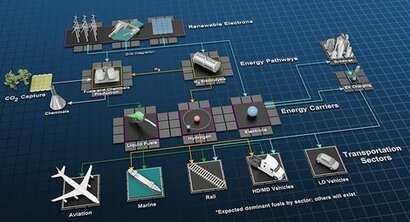
The transport sector is the largest source of greenhouse gas emissions in the United States, accounting for about 28 percent of total carbon emissions. Turning that metric to zero stands as a critical task in the global push to drive down emissions to avoid the worst impacts of climate change.
According to the Intergovernmental Panel on Climate Change, greenhouse gas emissions must be reduced by 50 percent – 85 percent by 2050 to limit global warming to two degrees Celsius (four degrees Fahrenheit).
To help light that path to net-zero emissions, NREL has published a strategy rooted in cross-cutting research and engineering to enable industry stakeholders, communities, government agencies, and early adopters to meet their climate goals.
“At the basic level, our strategy is simple: pair the best technology with the right application - whether that’s an electrified ride to school, a hydrogen-fuelled big rig, or a commercial flight powered by low-carbon biofuel” said Chris Gearhart, director of NREL’s Centre for Integrated Mobility Sciences. “We envision a mobility system fuelled with clean, renewable energy, delivered directly by vehicle electrification, or indirectly by low-carbon, energy dense fuels and renewable hydrogen for those sectors, like marine and aviation, that are harder to electrify.”
NREL’s science-driven approach for decarbonizing transportation utilizes decades of the laboratory’s clean energy research and arrives as major shifts are occurring in the 21st century mobility landscape. Fewer commuters are on the roads as telecommuting becomes more prevalent, yet the rise in e-commerce has placed greater demands on legacy freight mobility systems. The US population continues to grow and age. New technologies, fuels, and business models are on the horizon, forcing a reevaluation of ‘normal.’
“The spectrum of technological, social, and environmental shifts happening today requires a novel research agenda” added Johney Green, associate laboratory director for NREL’s Mechanical and Thermal Engineering Sciences. “As the only federal laboratory dedicated to research, development, commercialization, and deployment of renewable energy and energy efficiency technologies, NREL takes a whole-systems approach to solving energy challenges with long-term trends in mind, providing a roadmap of integrated technologies and energy pathways to get us to our destination.”
In NREL’s vision, adapting to such shifts and meeting the call to reduce emissions demands a research mindset that looks beyond individual technologies. Rather, it is a multi-pronged strategy that provides the scientific building blocks for advancing important research and engineering priorities, such as:
Accelerating innovations in vehicle technologies, such as increased vehicle electrification (batteries and fuel cells), connectivity, and automation
Increasing transportation efficiency by reducing emissions and decarbonizing transport across the light-, medium-, and heavy-duty vehicle; rail, aviation, and marine sectors
Maximizing future use of renewable electrons through time- and sector-shifting, a process encompassing storing renewable electrons as hydrogen, liquid fuels, and chemicals (to be used in long-term storage)
Optimally integrating transportation with buildings, the grid, and renewables to realize system-wide benefits.
Long a leader in transportation decarbonization research, NREL’s leading scientists and cutting-edge facilities have prepared the laboratory to innovate emerging technologies and trends from a variety of angles.
Like bioenergy, hydrogen sits at the center of NREL’s strategy for a transportation system decoupled from carbon emissions. While today’s market for hydrogen as a transportation fuel is limited to California and parts of Hawaii and the East Coast, experts at NREL think it will play an increasingly key role across the country to store energy and provide the emissions-free muscle needed for heavy-duty trucking, rail, and marine freight.
For additional information:

